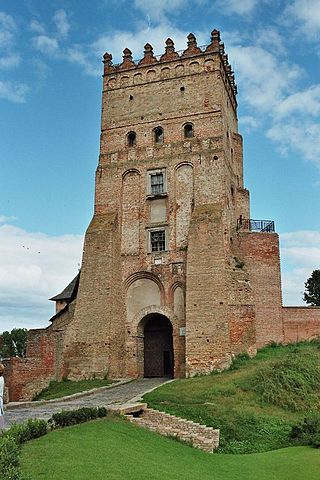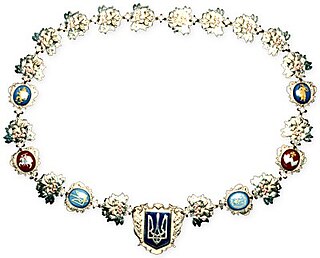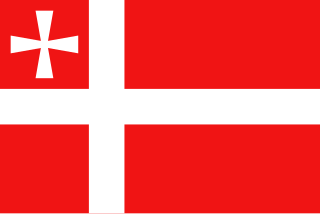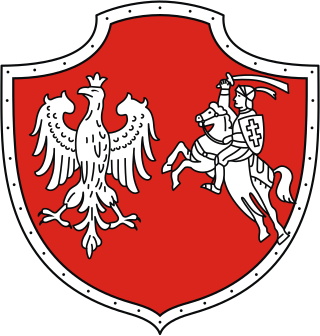
Galicia is a historical and geographic region spanning what is now southeastern Poland and western Ukraine, long part of the Polish–Lithuanian Commonwealth. It covers much of the other historic regions of Red Ruthenia and Lesser Poland.

Volhynia, is a historic region in Central and Eastern Europe, between southeastern Poland, southwestern Belarus, and western Ukraine. The borders of the region are not clearly defined, but the territory that still carries the name is Volyn Oblast, in western Ukraine.

Volhynian Voivodeship was a unit of administrative division and local government in the Grand Duchy of Lithuania from 1566 until 1569 and of the Polish Crown within the Polish–Lithuanian Commonwealth from the 1569 Union of Lublin until the Third Partition of Poland in 1795. It was part of the Ruthenian lands in the Lesser Poland Province.

Kovel is a city in Volyn Oblast, northwestern Ukraine. It serves as the administrative center of Kovel Raion within the oblast. Population: 67,575.

The coat of arms of Lithuania is a mounted armoured knight holding a sword and shield, known as Vytis. Since the early 15th century, it has been Lithuania's official coat of arms and is one of the oldest European coats of arms. It is also known by other names in various languages, such as Waykimas, Pagaunė in the Lithuanian language or as Pogonia, Pogoń, Пагоня in the Polish, and Belarusian languages. Vytis is translatable as Chase, Pursuer, Knight or Horseman, similar to the Slavic vityaz. Historically – raitas senovės karžygys or in heraldry – raitas valdovas.

The Principality or, from 1253, Kingdom of Galicia–Volhynia, historically known as the Kingdom of Ruthenia, was a medieval state in Eastern Europe which existed from 1199 to 1349. Its territory was predominantly located in modern-day Ukraine, with parts in Belarus, Poland, Moldova, and Lithuania. Along with Novgorod and Vladimir-Suzdal, it was one of the three most important powers to emerge from the collapse of Kievan Rus'. The main language was Old East Slavic, the predecessor of the modern East Slavic languages, and the official religion was Eastern Orthodoxy.

The coat of arms of Ukraine is a blue shield with a gold trident. Officially referred to as the Emblem of the Royal State of Volodymyr the Great, or, colloquially, the tryzub, the insignia derives from the seal-trident of Volodymyr the Great, the first Grand Prince of Kyiv.

Ostrogski is a Polish coat of arms of the Polish–Lithuanian Commonwealth. A variant of the Leliwa and Ogończyk coat of arms.

The House of Ostrozky was one of the more prominent Ruthenian families in the Kyivan Rus and later in the Grand Duchy of Lithuania and in the Polish–Lithuanian Commonwealth. The family spanned from the 14th century Ruthenian noble Danylo Ostrozky to the 17th century Polish members. After the death of Janusz Ostrogski, the last male heir, most of the family's possessions passed to the Zasławski family.

A cross pattée, cross patty or cross paty, also known as a cross formy or cross formée, is a type of Christian cross with arms that are narrow at the centre, and often flared in a curve or straight line shape, to be broader at the perimeter. The form appears very early in medieval art, for example in a metalwork treasure binding given to Monza Cathedral by Queen Theodelinda, and the 8th-century lower cover of the Lindau Gospels in the Morgan Library. An early English example from the start of the age of heraldry proper is found in the arms of Baron Berkeley.
The Volhynians were an East Slavic tribe of the Early Middle Ages and the Principality of Volhynia in 987–1199.

The coat of arms that serves as the symbol of the Lublin Voivodeship, Poland depicts a white (silver) male jumping cervus (deer), with a yellow (golden) crown on its neck, placed on a red background. The current design of the coat of arms was designed by Andrzej Heidrich, and adopted in 2002.

Zviahel is a city in Zhytomyr Oblast, northern Ukraine. The city serves as the administrative center of Zviahel Raion (district). Population: 55,086.

The sign (collar) of the president of Ukraine weighs about 400 grams. The president's collar is not obligatory, but most European heads of state have such a decoration: for instance, the president's collar is one of the symbols of state power in Poland and Bulgaria. Some countries grant another collar to the new head of the state, and the previous one passes to the national museums. An open-work chain with a historical relic – an amulet which, as the legend reads, belonged to Ukrainian Hetman Ivan Mazepa – was among the attributes of the president of Ukraine in exile.

19th Volhynian Uhlan Regiment was a cavalry unit and brigade from the Polish Army in the Second Polish Republic. Formed in 1917, it fought in the Polish–Soviet War and the Invasion of Poland. In the interbellum period, the regiment was garrisoned in Ostrog, Volhynia.

The House of Wojtowicz from Volhynia was a part of the nobility of Poland. The village of Wojtowice of Ostróg County in Volhynia is the origin of this house.

Flag of Volyn region is a banner with aspect ratio 2 to 3. In the center on a red background is an isosceles cross of white (silver) color, touching the ends of the edges of the flag. In the upper left corner is one of the oldest versions of the historical crosses of Volhynia of the 15th to the 18th century centuries.

The coat of arms of the Republic of Central Lithuania, an unrecognized short-lived puppet republic of Poland, was established on 12 October 1920 and remained in use until 18 April 1922, when the state ceased to exist.

The flag of Vinnitsa Oblast is a flag which, together with the coat of arms, is the official symbol of the Vinnytsia Oblast, Ukraine. Approved on July 18, 1997.

The coat of arms that serves as the symbol of the Podlaskie Voivodeship, Poland is divided into two horizontal red fields. The top field depicts a white eagle, and a bottom field, a knight in a white (silver) armor, sitting on a white (silver) horse with a blue saddle and shabrack, and yellow (golden) harness, standing on its back hoofs. The knight has a blue shield with a yellow (golden) cross of Lorraine on it, put on his left arm, and hold a sword in his right hand. The current design of the coat of arms was designed by Tadeusz Gajl, and adopted in 2001.





















